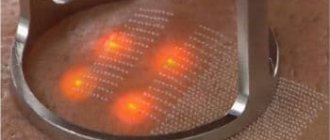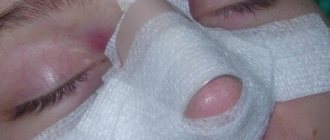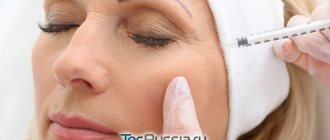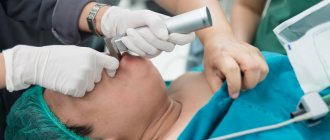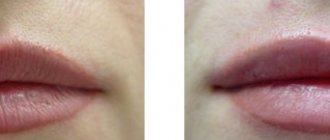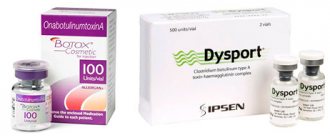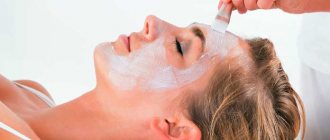Youth, as you know, is a state of mind. It’s wonderful when everything inside you sings and enjoys life. But if on your face, pardon the pun, all the signs of age are “present” in the form of wrinkles, folds, flaccidity and drooping tissue, it is difficult to maintain youthful enthusiasm and confidence in your attractiveness.
Fortunately, modern aesthetic medicine can offer many ways to give your face a second youth. The most effective methods include facial plastic surgery, namely a circular lift.
A circular facelift, or facelift, is one of the oldest and most popular surgical rejuvenation techniques. This operation involves removing excess skin and fatty tissue, returning soft tissues to their original position and giving the contours of the face their former clarity.
The natural result of a facelift is a visible rejuvenation of the face by ten years or more.
What is a facelift?
A facelift is a facelift that can correct almost all age-related changes. During the operation, the skin of the face and neck is corrected, as well as excess skin and fatty tissue are removed. You will look, on average, 10 years younger. In our clinic, you can be sure of an excellent result: the knowledge and experience of plastic surgeons at the RAMI clinic, as well as the modern surgical techniques and technologies used, guarantee you a gorgeous appearance.
Prices for facelift – from 143,000 rubles. * *
This is not a public offer. The final cost of the operation is determined after consultation with a doctor. Additionally paid: preoperative examination, anesthesia, hospital stay and compression garments.
Postoperative rehabilitation treatment is an integral part of a complex service - surgery, in accordance with internal standards developed at the RAMI Clinic.
The cost of rehabilitation treatment after facial surgery is 18,480 rubles.
View price
Why is a total facelift performed?
Today there are many surgical methods for rejuvenation. It is clear that it is quite difficult for the patient to determine on his own which of them is suitable for solving his individual problems. I can help with this decision only after a personal acquaintance and assessment of the condition of the tissues.
A total facelift is carried out if the following problems are observed:
- loss of clear lines and contours of the face,
- “double chin” effect caused by drooping and sagging tissue in the lower area of the face,
- the presence of nasolabial folds and jowls,
- drooping corners of the eyes,
- loss of firmness and elasticity of the soft tissues of the face,
- severe skin ptosis, in which cosmetic procedures will be useless.
The effect after a total facelift
I like to call a total facelift a “serial plan to save your youth” because this operation truly provides the opportunity to achieve a beautiful final result.
The skin is noticeably tightened, becomes elastic, the attractive oval of the face is restored, contours and features become clearer and more graceful, drooping corners of the eyelids are tightened.
All this together gives the necessary rejuvenating effect. Usually my patients claim that after a total facelift they began to look 10-15 years younger.
Changes after total facelift:
- Eyebrows rise
- Horizontal wrinkles in the forehead area are smoothed out
- The skin on the bridge of the nose becomes smooth
- Minimizes the depth of wrinkles in the area around the eyes
- Bags under the eyes disappear
- The cheekbone area is completely rejuvenated, gaining clear lines
- Ptosis of facial tissues is eliminated
- Facial oval is restored
- The double chin effect disappears
- The cervical-mental angle becomes clear
- Wrinkles on the neck are smoothed out
Facelift methods
Currently, the following facelift options are possible:
- full facelift (“circular facelift”);
- lifting the upper third of the face with endoscopic brow lifting (these are so-called modern minimally invasive techniques, since several small incisions are made in the scalp, the hair (hair follicles) is not damaged, and the incisions heal almost without a trace);
- mid-face lift;
- lifting the lower third of the face with/without liposuction of the chin area;
- platysma-plasty (surgery to remove sagging neck muscles).
Relevance and demand for the facelift procedure
The face is that part of the body that distinguishes a person from the crowd and makes him unique, that is, it is his individual feature. In addition, it is by this that one can determine age.
Over time, a person's face begins to change, and the reason for this is stretching, as well as the loss of collagen fibers that make up the skin framework. Of great importance in this process is a decrease in elastin content in tissues and a decrease in fluid. As you know, the face is always visible, that is, it is not protected from environmental influences in the form of ultraviolet radiation, low and high temperatures, dry air or wind. Often the reasons for changes in appearance in a negative direction are burns (chemical and thermal), mechanical injuries, occupational factors, consequences of metabolic diseases, etc.
According to experts, there are only five signs of facial fading:
- Wrinkles form.
- Skin elasticity decreases.
- Age spots appear.
- The volume of tissue disappears (sunken cheeks).
- The dermis begins to sag.
There are also minor signs of aging, which include the appearance of spider veins, local expansion of capillaries (telangiectasia), age-related warts (senile keratomas), swelling around the eyes (in the orbit area), increased porosity of the skin, hair on the chin and above the upper lip.
We recommend
Laser aesthetic cosmetology: the perfect technique for an ideal appearance More details
However, every woman wants to remain beautiful for as long as possible, so she begins to fight external defects both independently and with the help of cosmetologists. As a rule, the use of masks, creams, hardware rejuvenating procedures, and proper nutrition help to significantly improve the condition of the skin, reduce the number of wrinkles and refresh the complexion.
However, the severity of the result may differ for each person and in some cases may not suit the patient. In addition, success is always variable, requiring periodic repetition of procedures. In order to get tangible changes that will last for a long time, it is necessary to resort to surgical methods of rejuvenation, for example, facelift, which is considered the most effective option for the face.
Preoperative preparation
During a consultation with a plastic surgeon, the question of the need to perform a facelift (“circular facelift”) and its volume is decided. Quite often, facelift is combined with eyelid rejuvenation surgery - blepharoplasty (upper and/or lower) and lipofilling. An examination is performed before the operation. Photographs are also taken before the operation itself in order to compare the results before and after the operation. Facelift is performed under intravenous anesthesia in combination with local anesthesia. The duration of the operation depends on its volume, on average it takes from 2.5 to 4.5 - 5 hours.
Plastic surgeon – Yastrebova Natalya Mikhailovna
How is a total facelift performed?
What is the main feature of this operation? Tissue correction is performed sequentially at different levels: during the operation I work not only with the skin, but also with the fat layer and deep muscle-aponeurotic structures.
A patient who hears these concepts for the first time may experience fear: “What if this is dangerous?” Let me reassure you: there is no reason to worry.
This is a precisely proven technique that I have been working with for many years. In my practice, there have never been any problems. The patients and I consider all the results successful. There is no risk to health, since the nerve endings are not affected during the operation.
Anesthesia
A total facelift is performed under general anesthesia.
Accesses
Open and endoscopic access is used.
Progress of the operation
- Surgical access (diameter 15-20 mm).
- Endoscopic lifting of the forehead, eyebrows and temples.
- Upper and lower blepharoplasty (eyelid surgery).
- Excision of excess tissue in the eyelid area.
- Endoscopic midface lift.
- SMAS-lift – work with the aponeurotic layer.
- Platysmaplasty, in which the stretched neck muscle is sutured.
“For each patient, I always develop a special strategy, based on his individual facial features and the degree of tissue ptosis, the nature of age-related changes. For example, sometimes I can refuse upper blepharoplasty if I see that there is no need for it.”
Rehabilitation
Immediately after completion of the operation, a recovery period begins, which lasts several months. Let's figure out what happens during this period, what you should be prepared for, what the patient can and cannot do during rehabilitation.
First day
After a circular facelift, the patient needs to be under my supervision in the hospital for 1-2 days. On this day you need good sleep, rest and peace. The patient can then return home. For the first days, the patient wears a special mask-bandage, which can be removed after a few days.
First 2-3 weeks
At first, you may experience swelling and bruising, pain, stiffness, and fatigue. All of the ailments listed are natural for early recovery, so they should not cause serious concern. I will tell you during the meeting about how to alleviate the condition in the first weeks.
Restrictions
Restrictions and prohibitions are temporary. The first time after a total facelift, you will need to remember them, then you will be able to return to your normal life again.
- You cannot use cosmetics.
- Adequate healthy sleep and rest are important.
- It is necessary to reduce any types of loads.
- Cancel trips, trips and events that involve physical work.
- Avoid direct exposure of skin to sunlight.
- Do not wear glasses for the first time after surgery.
- Don't sleep on your stomach (face on the pillow).
- Avoid touching your face and neck with your hands.
- Do not visit the swimming pool, bathhouse, sauna, or fitness center. Any gymnastic exercises, exercises, dancing and house cleaning involve a certain amount of physical activity, which is unacceptable in the early days of recovery!
- You cannot steam the skin, make masks and compresses, massage the face, cleanse the skin with lotions and scrubs, or do peeling.
- Many cosmetic procedures during the rehabilitation period are contraindicated.
Postoperative period
After a facelift, a special bandage is applied that must be worn for several days after the operation. The sutures are removed after 12–14 days.
You need to be prepared for the fact that the postoperative period is accompanied by the appearance of hematomas (bruises) and swelling on the face, which disappear within 2 - 2.5 weeks. Another concern may be a decrease in sensitivity on the face, which is also gradually restored.
Typically, after a facelift, patients can start working within 2 weeks.
The rehabilitation period can be significantly accelerated and facilitated by a course of rehabilitation procedures in our clinic. The course includes modern methods and approaches, promotes rapid recovery of patients, reduction of edema and hematomas, restoration of sensitivity and blood supply to tissues.
You can receive all the necessary recommendations and indications for performing a facelift during a face-to-face consultation with our plastic surgeons.
Turn back time, feel youthful and confident! We are waiting for you at the RAMI clinic!
If you are really looking for your doctor...
Types of facelift
- Classic surgical lift.
This is a highly traumatic surgery because it involves large tissue incisions. The most common procedure is a circumferential lift, which involves making incisions behind the ears, along the hairline, and under the chin. The purpose of the operation in this case is to remove excess skin. The effect of the surgical intervention lasts for several years.
- Endoscopic lifting.
This type of surgery is less serious. Compared to plastic surgery, there is no excision, and the incisions are no more than 2 cm in length. The manipulation is performed under general anesthesia. Its essence is to return connective tissue that has shifted due to age-related changes to its original place, as well as remove fat.
- Temporal (temporal) lifting.
A temple lift is a diagonal lateral face lift in problem areas, resulting in rejuvenation of the skin on the forehead, around the eyes and on the cheekbones.
The main disadvantage of this type of facelift is its price, which fluctuates around 50–80 thousand rubles.
- Blepharoplasty.
With this procedure you can get rid of bags, circles under the eyes, as well as fatty hernia. The transconjunctival method can be used, that is, the operation is performed through an incision made on the inside of the eyelid. This surgical intervention allows you to tighten the skin, remove bags and fatty hernias. However, the specialist who performs this operation must have high skill in surgery, as well as be extremely careful and attentive.
- Aqualifting.
This method of facelift is considered the most harmless. In this case, small punctures (up to 3 mm) are used behind the ears and in the chin area, through which the fat layer located between the muscles and the skin is washed with thin streams of water. A vacuum is used to remove fat from these areas.
This method of rejuvenation is suitable for women of any age and is performed under local anesthesia. The result of the procedure is a toned face without wrinkles, swelling, with smooth skin and a healthy color.
- Thread facelift.
This is a minor surgical intervention during which special threads that tighten the epidermis are inserted under the skin. With their help, a collagen frame is created that lasts for two years.
For the operation, anesthesia is used, in some cases even general. Fixation of the threads under the skin is carried out using small knots or notches. The procedure lasts about 30 minutes.
Thread facelift allows you to get smooth and youthful skin.
The duration of the entire operation ranges from 40 minutes to six hours. The result lasts for 5–7 years.
- Hardware lifting.
This is a fairly effective and at the same time painless type of facelift, as evidenced by patient reviews. It allows you to return 5-10 years to your appearance, launch the synthesis of collagen and elastin, and also prevent skin sagging. In the fight against age-related changes, hardware lifting is quite effective.
- RF lifting.
The method involves heating collagen fibers at a temperature of +65 °C under the influence of radio waves, as a result of which they are restored and strengthened. In addition, fat breakdown occurs. The skin becomes more elastic, smooth and acquires a healthy color.
The procedure lasts from 15 minutes to two hours. Before the session begins, the skin is cleansed and a conductivity-improving gel is applied. After the preparatory procedures, the skin is massaged using special attachments, during which the patient may feel tingling and warmth. It is worth noting that the effect can be seen immediately after completion of the session: the face becomes toned.
In order for the result to last as long as possible, radiolifting should be carried out in a course (6–12 procedures), which is repeated periodically once or twice a year.
- SMAS -lifting.
Until 1976, only a superficial facelift was used, without affecting the subcutaneous layers. It was this year that became revolutionary in plastic. Surgeons Peyronie and Mitz suggested working with a single layer, which includes the skin, aponeurosis and muscles, in order to achieve a natural tightening effect. This operation is called SMAS-plasty. It is worth noting that this facelift method is still used today, and quite successfully.
SMAS plastic surgery involves exposure of the deep layers of the epidermis (5 mm) to ultrasonic waves, resulting in the formation of new collagen fibers. The procedure allows you to get rid of facial wrinkles, improve the shape of your face, and also reduce nasolabial folds.
The duration of the session is no more than an hour. After the skin is treated with a gel with an anesthetic effect, the master begins to work with a special apparatus. In order for the patient to appreciate the result that is visible immediately after the procedure, the manipulation is performed first on one half of the face and then on the other. When the session is completed, a soothing agent is applied to the skin, thanks to which the epidermis acquires a natural color in just a few hours.
The effect of SMAS lifting remains pronounced for six months. It is recommended to repeat the procedure once every few years.
- Photorejuvenation.
The method involves laser heating of the top layer of skin, resulting in the burning of old cells, as well as activation of the synthesis of collagen and elastin fibers.
Thanks to photorejuvenation, you can achieve a whitening effect, reduce the number of “stars” that appear with rosacea, reduce inflammation, narrow and cleanse pores. The duration of one session is 15–60 minutes.
To maintain the result, you must complete a course of 3–7 procedures, which should be performed every three to four weeks, once or twice a year.
To do photorejuvenation, it is not necessary to go to specialized institutions. You can purchase the device for home use.
- Laser lifting.
This rejuvenation method also involves exposing the skin to a laser beam, but this procedure, unlike phototechnology, is more radical. A facelift using this method gives a quick and pronounced effect. However, it is considered much more traumatic because recovery takes longer. When using a laser, regenerative processes are improved, blood flow is stimulated, and old cells are removed.
In order for the results to last as long as possible, it is necessary to carry out at least 2-5 procedures every year.
- Microcurrent tightening.
The manipulation involves applying a special device to the skin. However, first you need to apply vitamin preparations to the surface to be treated. After this, the problem areas are exposed to weak current discharges. Thanks to this, multiple contractions of the muscles of all layers of the dermis occur and collagen production is stimulated.
This procedure allows you to reduce the number of wrinkles, as well as moisturize and tighten your facial skin. To maintain the effect, an annual course of 10–15 sessions should be carried out.
- Myostimulation.
The purpose of this procedure is to restore the functional activity of muscle fibers. This is achieved by applying electric current to certain areas of the body using a myostimulator. As a result, the contraction of fibers in individual muscle groups improves.
- Injection face lift.
This rejuvenation method involves subcutaneous administration of drugs. Due to the fact that they enter the cells directly, their action begins immediately, and a positive effect is observed immediately after the procedure. As a rule, injections simultaneously heal and rejuvenate the skin, and the results last a long time and are more pronounced.
We recommend
How to get rid of unwanted hair quickly, painlessly and permanently Read more
- Plasmolifting.
In this case, the injections use the patient’s own blood plasma, enriched with platelets, which improve cellular turnover, resulting in younger-looking skin. Plasmolifting allows you to tighten the epidermis and restore the natural complexion.
The session lasts 30–45 minutes. Blood is taken from the patient to further separate the plasma and enrich it with platelets. After this, it is injected under the skin, after numbing the treated area with an anesthetic gel. The punctures are so small that they hardly injure the skin.
The result of the procedure becomes noticeable a few days after it is performed. To maintain the effect, a course of five to six sessions is required with a frequency of three to four weeks and annual repetition.
- Biorevitalization.
This method is also an injection. In this case, hyaluronic acid is injected under the skin. It is worth noting that the human body produces it independently, but over time the natural process slows down. This substance is contained in the fluid that is located between the cells and is responsible for the production of elastin and collagen necessary for the elasticity of the skin.
It is worth noting that the procedure is quite painful and therefore requires preliminary anesthesia. In addition, bruising may be observed for some time after the injections.
However, the result of biorevitalization is visible immediately, that is, wrinkles become less noticeable, the skin is moisturized and tightened. To maintain the effect, the manipulation must be repeated every year in a course of six to seven sessions.
- Mesotherapy.
This method of rejuvenation also involves the use of injections using various drugs (hormones, enzymes or plant extracts, vitamins), which are selected depending on the problem that worries the patient. Mesotherapy helps get rid of skin unevenness, acne and wrinkles, excessive sweating, and makes the skin elastic.
Like many anti-aging procedures, it is done in a course that includes ten sessions. The effect of mesotherapy lasts for a year.
- Vector lifting (fillers).
The essence of the method is that special injection threads with calcium hydroxyapatite and hyaluronic acid are injected under the skin. The face immediately becomes more youthful, areas with sagging dermis disappear.
The results from vector lifting last from eight months to two years.
Preparing for surgery
Before the operation, the patient must undergo a complete medical examination. The surgeon needs comprehensive information about the patient's health status in order to assess possible complications. It is extremely important for the patient to inform the doctor about hidden problems, and in particular those related to blood pressure, blood clotting, or the tendency of tissue to become excessively scarred. You should also inform about the medications you are taking, especially those that affect blood clotting. The surgeon should also be aware of whether the patient smokes or drinks alcohol.
Only after collecting the necessary information about the patient, the specialist begins a detailed examination of his face. During the operation, the anatomical structure of subcutaneous fat and muscles, the facial skeleton and the general condition of the skin are taken into account. At the initial consultation, the surgeon discusses the results of the future operation with the patient and suggests possible alternative facelift techniques. Patient preparation begins 10 days before surgery. During this period, quitting smoking and alcohol and taking hormonal medications is indicated. The day before the operation, you are allowed to eat only liquid food, and on the day of the operation you must completely stop eating.
The operation is performed under general inhalation anesthesia. Mini-facelift (local lifting) can be done under local or intravenous anesthesia.
Contraindications to the facelift procedure
To avoid side effects and carry out a facelift without harm to health, you need to know that facelift has certain contraindications.
The procedure cannot be done in the following cases:
- During pregnancy and breastfeeding (possible harm to the health of the baby, the pregnant woman, as well as premature termination of pregnancy).
- Age up to 30 years.
- Presence of chronic diseases (diabetes mellitus).
- HIV.
- Tuberculosis.
- Anemia.
- Severe diseases of internal organs in the acute stage.
- Oncological pathologies.
- Problems with the central nervous system, for example, neurosis, depression.
- Some time after surgery due to weakened immunity.
- A certain period after a heart attack or stroke.
- Problems with blood clotting.
- Chronic diseases associated with the kidneys.
- Problems with the cardiovascular system (tachycardia, arrhythmia, bradycardia, etc.), vascular diseases and blood clots.
- Intolerance to certain drugs that are planned to be used during the facelift (the appearance of allergies). Before the procedure, the specialist must conduct a test to determine the body’s reaction to all medications that will be used.
- Diseases of an infectious or bacterial nature in an acute form.
- Skin problems (eczema, seborrhea, etc.).
- Inflammatory processes in the soft tissues of the face located in the joint area.
In addition, surgeons often refuse to perform a facelift on patients who are obese. The fact is that excess weight can lead to a negative outcome of the operation and complications.


